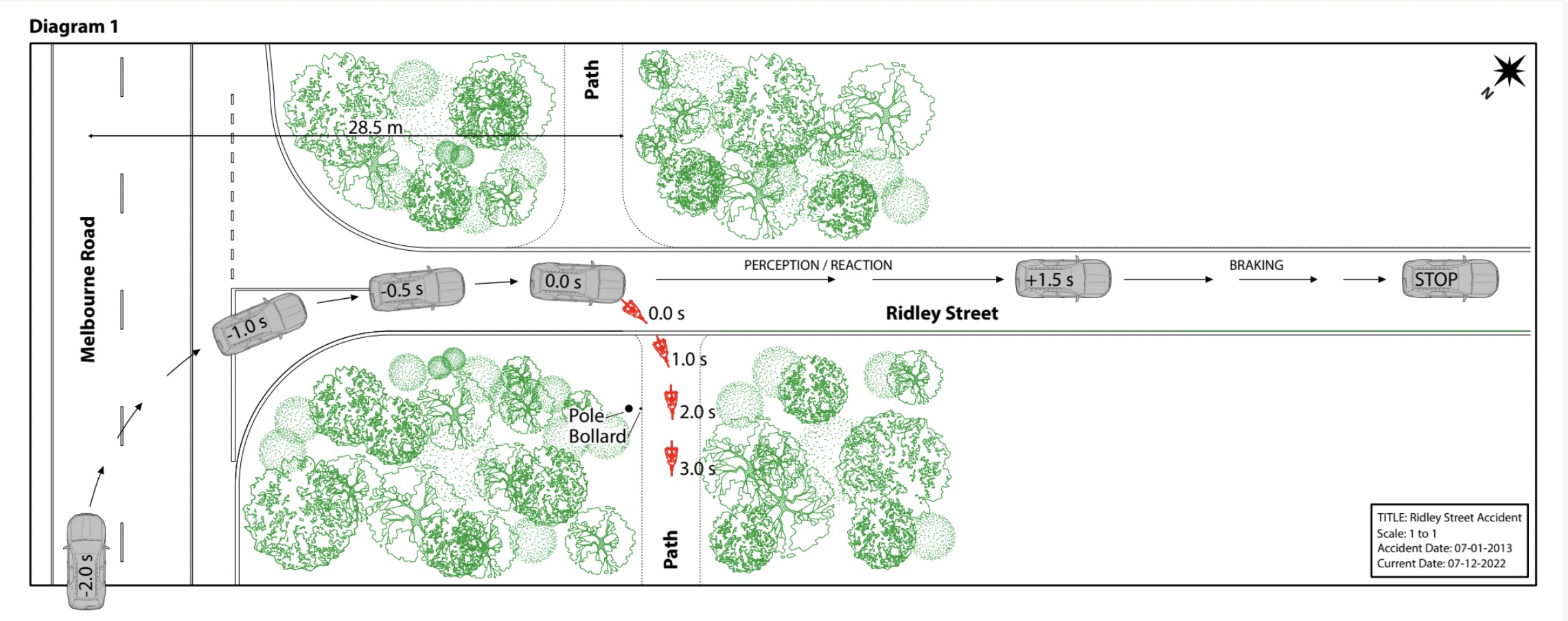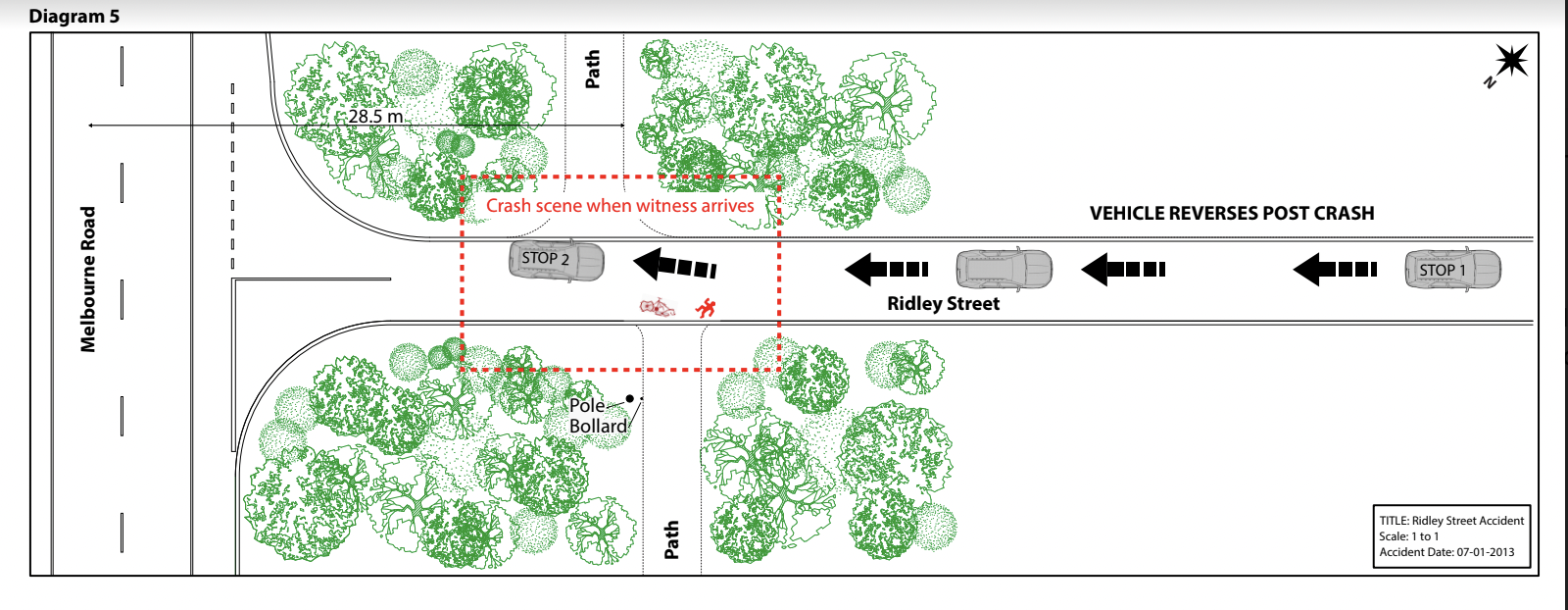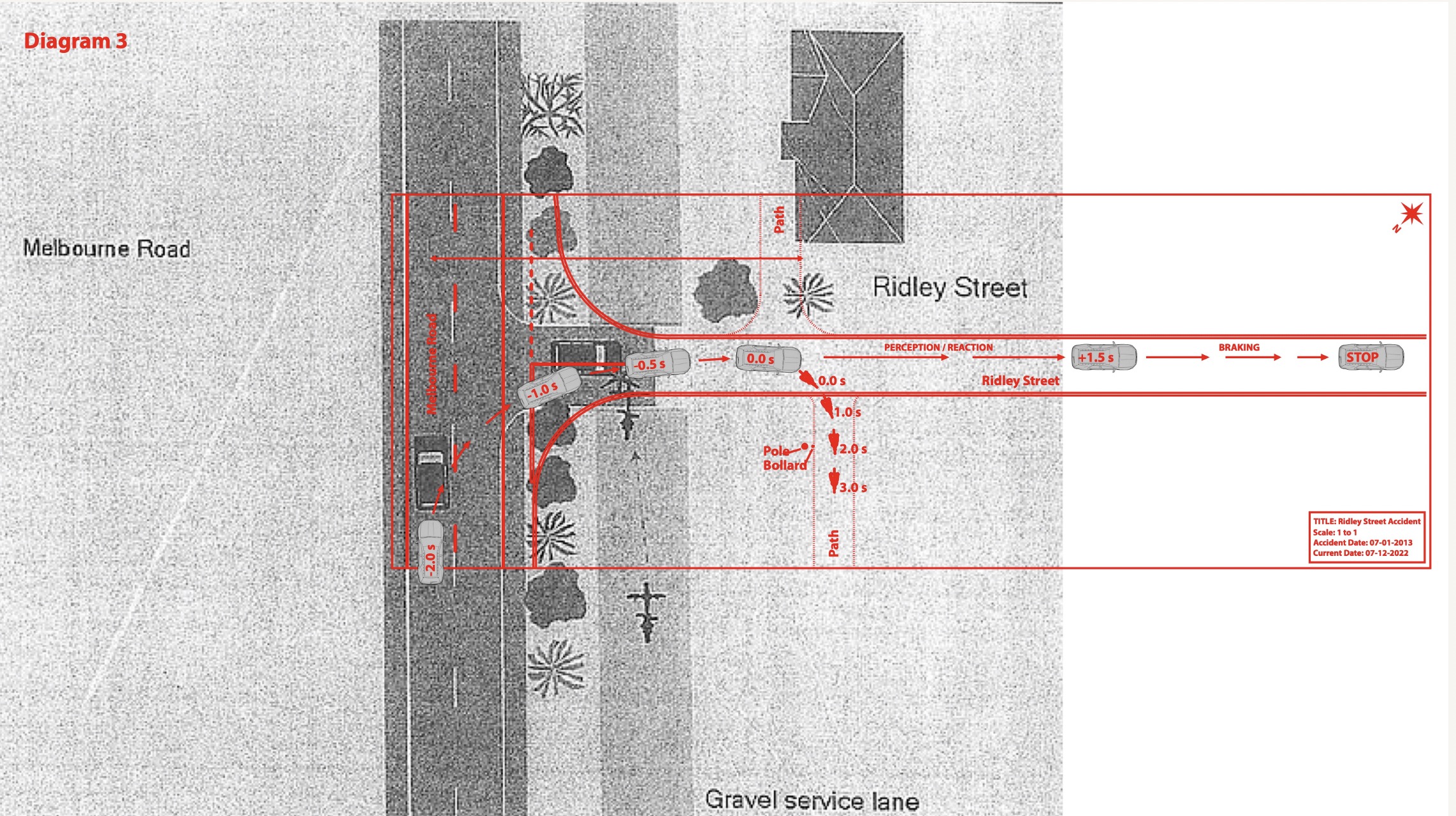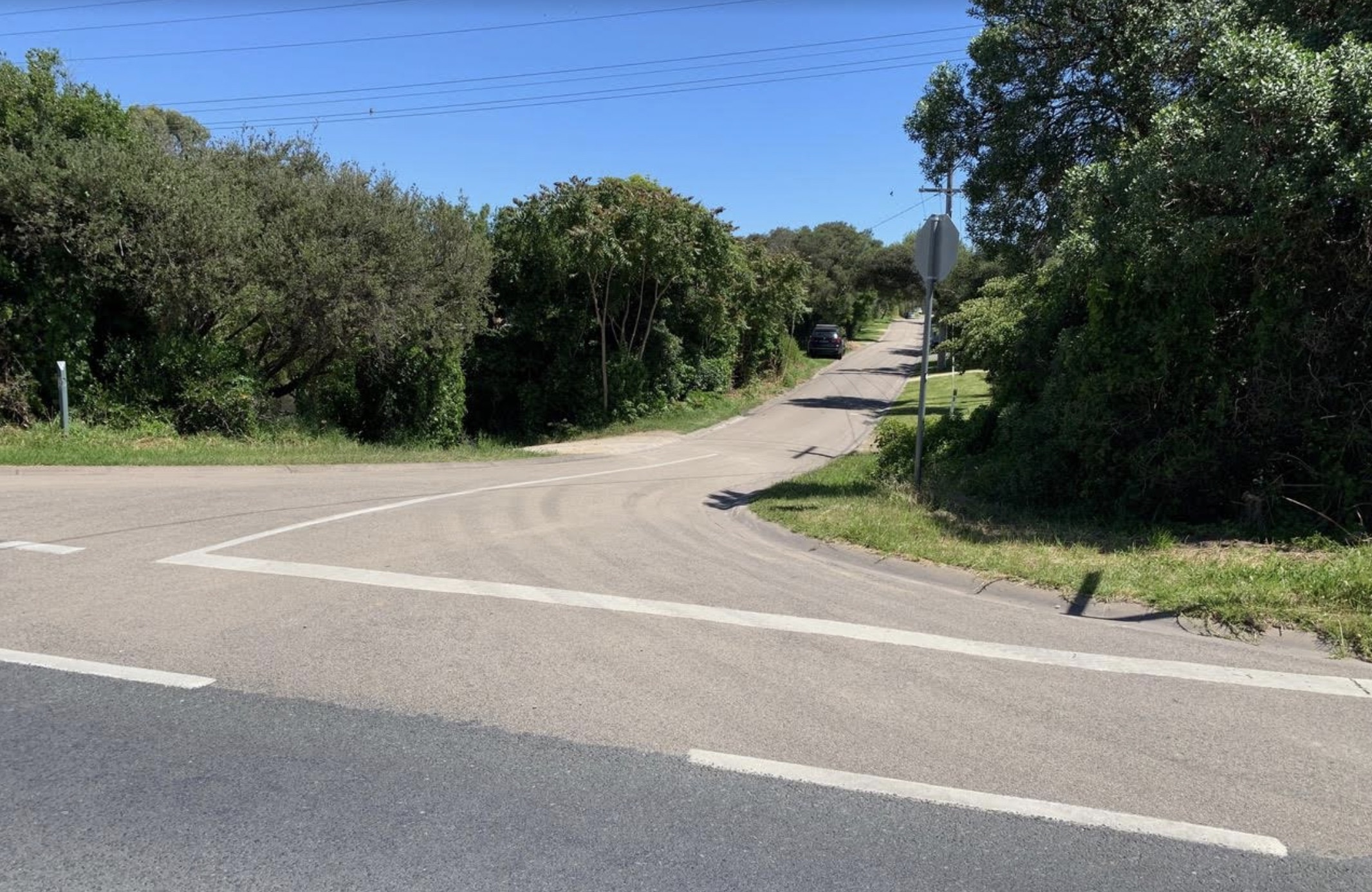Andrew L. Urban
After lunch, a little past 1pm on the hot summer afternoon of Monday, January 7, 2013, then Victorian Opposition Leader Daniel Andrews, his wife Catherine and their young children Noah then 11, Grace then 9 & Joseph then 5, were driving back to their rented holiday house in Ridley Street, Blairgowrie, on Victoria’s Mornington Peninsula.
The family’s Ford Territory travelled along Melbourne Road, south of Sorrento, in the direction of St Andrews Beach (no relation, just a wicked universe at play). Two blocks to their right was the vastness of Bass Strait; a few blocks to their left were the generous waters and beaches of Port Phillip bay, popular with holiday makers. They were coming back from the beach, according to their statements to police.
The Territory made a right turn into Ridley Street and, according to the official police/Andrews version, it was T-boned by a cyclist crashing into the right side. But in the ambulance report unearthed this April, it was the Territory that crashed into the cyclist who was turning left into Ridley Street. (See diagram 1)

When the Victorian ambulance report surfaced in the Herald Sun, it confirmed what a Melbourne Industrial Designer had months earlier figured out from the publicly available facts. According to Colin Robertson’s analysis, performed in December 2022, the Andrews car, travelling down the slope of Ridley Street from Melbourne Road, would have been travelling at around 60kph when it struck cyclist Ryan Meuleman, as he emerged from the path to the Territory’s right.
The Robertson analysis of the accident matches the ambulance report and makes a liar of the version maintained by police, which draws on the contemporaneous statement by Daniel Andrews.
The ‘Patient Care Report’ reads, “15YO on bike. Struck on L side by car travelling 40 to 60kmh … PT onto bonnet, then onto windscreen which cracked on impact … thrown onto roadway.”
“It’s actually reasonably easy to reconstruct a crash scenario,” Robertson says. “I’m an Industrial Designer, my expertise is in engineering, drafting and graphics. I’ve used accurate topography, the specifications of the Ford Territory, the cyclist’s injuries, witness statements and some basic physics.”
The first witness on the scene was neighbour Jane Crittenden, who almost ran into the Andrews car when she turned into Ridley Street. “They had hit this child who was lying on the road and my instinct was just to go straight to that child, so I got out and ran over,” she said. She said another local resident also came out to the scene “because it was a big hit”, adding Ryan Meuleman’s “bike was smashed up”, while “the wheels were all bent, it was a mess”.
Ms Crittenden “grabbed a towel” from her car and put it under the head of Mr Meuleman as it “was a burning hot day”.

Ryan’s concerned father Peter had gone to Rye police station to learn what had happened. “What were the circumstances? Was it speeding? Was it negligence? Was it driving under the influence? All of those things that I felt that I had the right to know as the father of a minor that was involved in that accident. But they disclosed nothing to me. I just got brickwalled – and I couldn’t understand that.”
The brickwalling might be more easily understood if it is put into context that the accident was potentially a career-ending event for the then Opposition Leader if the driver of the Territory was at fault, not the cyclist.
The January 7 crash only became public nine days after it occurred, when Ryan’s father Peter Meuleman contacted the Herald Sun. “Nine years on, Mr Meuleman says he still can’t understand the way Mr Andrews and his wife behaved after the crash,” Michael Warner reported in the Sun Herald (November 3, 2022).
How they behaved includes Daniel Andrews getting into the car and driving the unroadworthy Territory away from the crash scene, without undergoing a breathalyser, in front of attending police. According to the police report, his wife had been driving at the time of the crash. Robertson wonders if anyone saw the much taller Andrews adjust the front seat when he got into the Ford Territory?
“I was surprised to see the story surface officially, prior to the recent Victorian State election,” Robertson tells this writer. “This time, with names, actual data, witnesses, photos of the damaged vehicle and statements from Daniel and Catherine Andrews, the custodians of the vehicle. The site of the crash was also revealed and crucially, an official diagram from Victoria Police was supplied. The diagram showed the position of the Andrews vehicle relative to the cyclist and the point of impact. From the position of the car and bike before and after impact coupled with the Andrews’ formal statements, it was possible to deduce approximate speeds in their version.
“From the police diagram and the Andrews’ statements, the Andrews vehicle indicated right, then came to a complete stop on Melbourne Road. After waiting for a passing P plater heading in the opposite direction, the Andrews vehicle proceeded to make a slow, about 10 km/h, careful, right hand turn into Ridley Street.
“Almost immediately, the Andrews’ vehicle (having only travelled 6 meters) is stuck violently on the right hand side by a cyclist travelling across Ridley Street at great speed. From the Andrews’ statements, the cyclist was travelling at about 36 km/h (10 m/s). He struck the Andrews’ vehicle at a perfect right angle on the front/right corner panel, just beneath the headlight.” (See Diagram 3 – police & Robertson diagrams overlayed)

“The Police diagram doesn’t indicate the position of the cyclist or Andrews’ vehicle after the crash. From witness statements, the cyclist came to rest on the asphalt, behind the vehicle, on the right rear side.
“The photos of the damaged vehicle are puzzling,” says Robertson. “They show a Ford Territory with a crumpled front bumper and front right panel, a smashed windscreen near the A pillar on the driver’s side, a missing right rear vision mirror and a dented front right wheel arch panel. If the Andrews’ story is correct, the cyclist, after hitting the Andrews’ car at a perfect right angle on the front/right panel, is launched into the air at 10 m/s (metres per second), he then makes a 90 degree mid-air turn, hurtles onto the windscreen at the same velocity, is launched into the air again, then is scraped along the right hand side of the vehicle taking out the driver’s mirror and denting the front right wheel arch.”
The then 15 year old Ryan Meuleman, a local, was riding his sister’s hybrid bike on an unmade, sandy, path between his parent’s residences; he was wearing a helmet and a backpack, a box of tools strapped to the rear of the bicycle. He was making slow (about 10 km/h) but steady progress.
“As he approached Ridley Street, he slowed to a walking pace because thick vegetation blocked his view of the road. He looked left/right, slowed but didn’t stop, looked left once again, steadied himself with his left foot, turned slightly left, then proceeded across the culvert (gutter) and onto the asphalt. He made it about half way across. He saw and heard nothing until the Andrews’ vehicle was upon him, hitting him at an angle from his left hand side. His impression was that it must have been speeding to have come upon him so suddenly.”
That description fits with Robertson’s belief that the driver of the Territory (supposedly Mrs Andrews) cut the corner . That’s why Ryan didn’t see the car approaching.

Site of the crash (Colin Robertson photo)
Meuleman’s injuries included a punctured lung, broken ribs, internal bleeding and he was left with 10 per cent of his spleen. He spent 11 days in The Royal Children’s Hospital.
“The serious injuries to the left side of Ryan’s body and the observations made by the ambulance officers who attended the crash are completely inconsistent with the claims to police made by Mr Andrews and his wife that their vehicle was travelling at a low speed,” barrister Daryl Dealehr told the Herald Sun. “The evidence appears completely at odds with what Daniel and Catherine Andrews have been claiming since the collision.”
“the police/Andrews version impossible”
In a statement to police signed on February 5, 2013, at Springvale police station – almost a month after the accident – Mr Andrews declared: “We had turned right from a stationary position into Ridley St. Moments after we turned, a cyclist collided heavily with the side of our vehicle … the cyclist was travelling at speed and hit our car at a perfect right angle very heavily.
“I want to make it clear – the cyclist hit our vehicle.”
Robertson disputes this. He recorded his visit to the crash site. “My first impression upon arriving is that the crash site is massively further from the Melbourne Highway (about 400% further) than the official diagram indicates.” The official diagram posits that there was not enough space to allow acceleration prior to impact. But Robertson also noted that the entrance to Ridley Street is on a steep gradient leading down to the point of impact.
“The path is not a wide, straight track but an undulating, sandy unmade path, importantly, the path is offset by about 5 meters as it crosses Ridley Street. A cyclist crossing Ridley Street at speed, would most likely end up in the vegetation opposite, you HAVE to slow down in order to negotiate the turn.
“The path is used by cyclists, dog walkers and local vehicles, there’s pot holes, sticks, rocks etc; it’s not a path you could speed along even if you wanted to. Thick vegetation blocks the entrance to the path from Ridley Street, a clear view of the road is only possible 2 – 3 meters from the kerb. You can see the path as it was in 2013 on Google maps street view. The Northern end was wider in 2013 wide enough to drive a car.
“I made site measurements, took photos then made my way back onto Melbourne Road. At the time of the crash (2013), the speed limit was 80 km/h and in Ridley Street it appears to have been 50 km/h.”
The police/Andrews version of the accident isn’t just improbable, says Robertson, “it’s impossible.”
Outstanding questions Robertson wants answered:
Q: Who were the police officers who attended the crash? Have they been interviewed?
Why did they ignore police protocols to:
- Breath test the Andrews
- Allow Daniel Andrews to leave the scene in the collision vehicle.
- Impound the vehicle
- Close the road in preparation for a crash scene investigation unit.
Q: Who did Andrews call immediately after the accident? Was it a high ranking police officer?
Q: Who was the insurance agent/company acting for the Andrews/Vic Govt who/that contacted Mr Meuleman’s father? What do they know? Who instructed them?
Q: The oldest Andrews child, Noah was 11 at the time, only 4 years younger than the cyclist. Was he interviewed at the time? He would know/remember who was driving, his mother or his father.
Victoria Police did not lay any charges against either party at the time. Meuleman, now 25, is pursuing legal action over the incident.
After IBAC’s critical Operation Daintree was handed down at the end of April, Premier Daniel Andrews labelled the report “educational” and said the ministers and advisers named no longer worked in the government.
“damning report … speaks volumes”
The Victorian Ombudsman Deborah Glass hit out at the way the Premier responded to the report, saying his response was at odds with the contents.
“Describing it merely as an educational report that made no findings does not in any way describe that report,” Glass said. “It’s a damning report. I think that simply speaks volumes for his views on integrity and corruption.”
She compared IBAC’s report with findings she made in relation to the Labor Party’s “red shirts rorts” last year and the results of Operation Watts, a joint Ombudsman-IBAC probe that uncovered “extensive misconduct” by Victorian Labor MPs. In other words, these reports all go to character.
In 2017, Victoria’s Independent Broad-based Anti-Corruption Commission (IBAC) investigated the police response and found officers failed to breathalyse Catherine Andrews as would be normal after an accident.
However, IBAC clarified at the time it was “not investigating the incident or the conduct of the Premier, Mr Andrews, or any member of his family”.
Robertson, arguably a one-man Citizen Integrity Watchdog, wonders whether a new inquiry into the 2013 Andrews collision with the young cyclist, preferably by an interstate body, might also be educational for Daniel Andrews. Indeed, some critics of Daniel Andrews might hope it would teach him a lesson.

Great article, there is no way the cyclist was at fault. He deserves justice for the massive impact this must have had on his life
Andrews lied about everything else, and this is just one more lie which he has attempted used to get away with. But maybe, just maybe, this is the end of the road for Dan and he will be called to pay the piper. Not before time either.
Why is Robertson so interested🤔 Would he be so interested if it wasn’t a Labor politician involved. When this kind of dreadful thing happens why do people want to blame someone 🤔
I dunno, why do people want to blame someone? Could it be that someone was at fault?
I can’t comment on the accuracy or otherwise of this report.
What I can confirm from personal experience with far more tragic circumstances (death) is —- the police officers attending crash scene didn’t accurately record and act on, all relevant details. This failure exacerbated the distress for deceased’s family.
When errors/failures were questioned, cover-up and attempted passive bullying occurred.
It took persistence to gain admittance that there were errors. In the instance to which I refer, finally a far more senior officer visited family and admitted the ‘stuff-up’.
Our family had similar experience without the “Stuff Up Admitted” by Police taking months to bother to interview scene witnesses.
(Deceased Grandson)
Thus causing witnesses to have forgotten serious details.
Victorian Country Road, in need of major repairs “Police” claimed were at fault, then back peddled that opinion.
Unbelievable that Police have been negligible in so many tragic accidents and choosing when to follow protocols and when (who) not to.
Witness statements, breathalyser testing, vehicles and drivers leaving scene.
Rules for some, not all.
I’ve got some concerns with the article, as written.
I’ve studied the crash site using ‘Google instant street view’
[https://www.instantstreetview.com/@-38.372479,144.775518,353.94h,-21.31p,0z,xJMrIM4e9ve3HKhFR0JDxg]
From what I can gain from Andrew’s article, I do not see much to actually support the thrust of Andrew’s post. What I mean, is that the way the article reads, is that it’s in a ‘tabloid style’, not particularly ordered and strong on delivering ‘one (accusatory) side of a story’.
I’m happy to detail particular points to any fellow commenter to illustrate my misgivings with this article, as posted.
PS: As a youngster I knew something of the area … Port Phillip Bay to the north, Bass Strait to the south… the sandy lanes among the Ti-Tree (melaleuca) along the peninsula between.